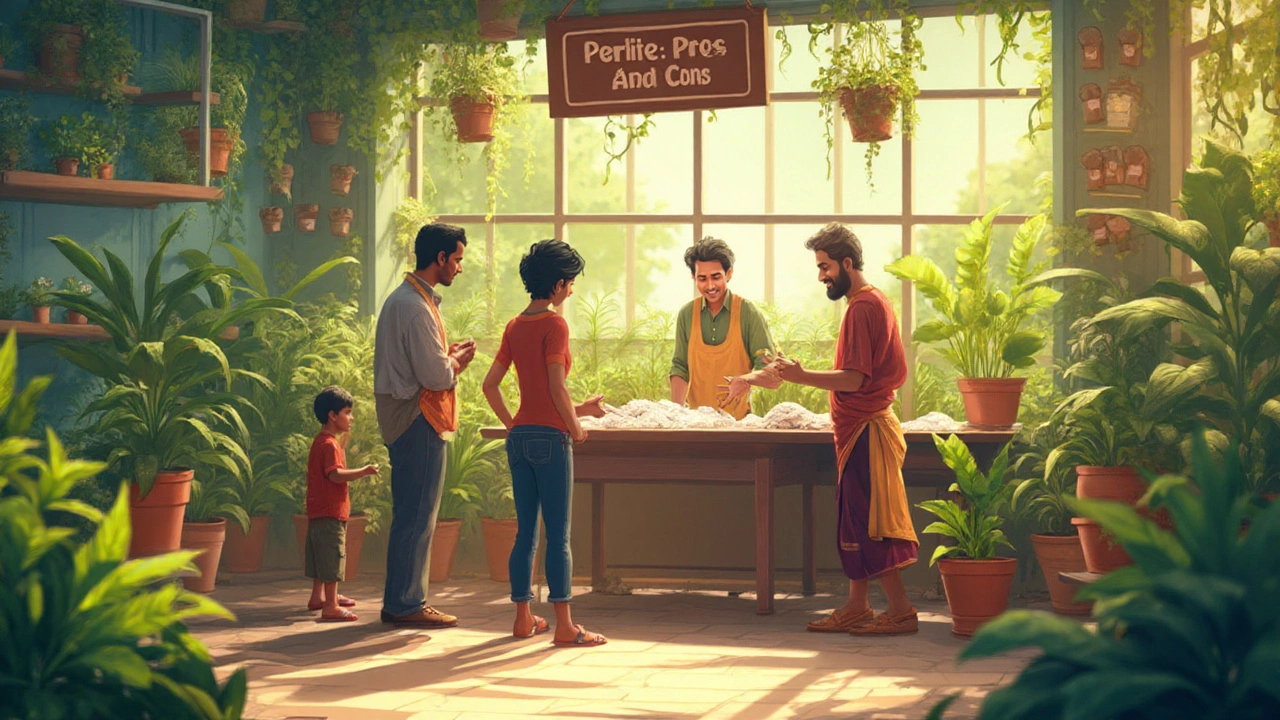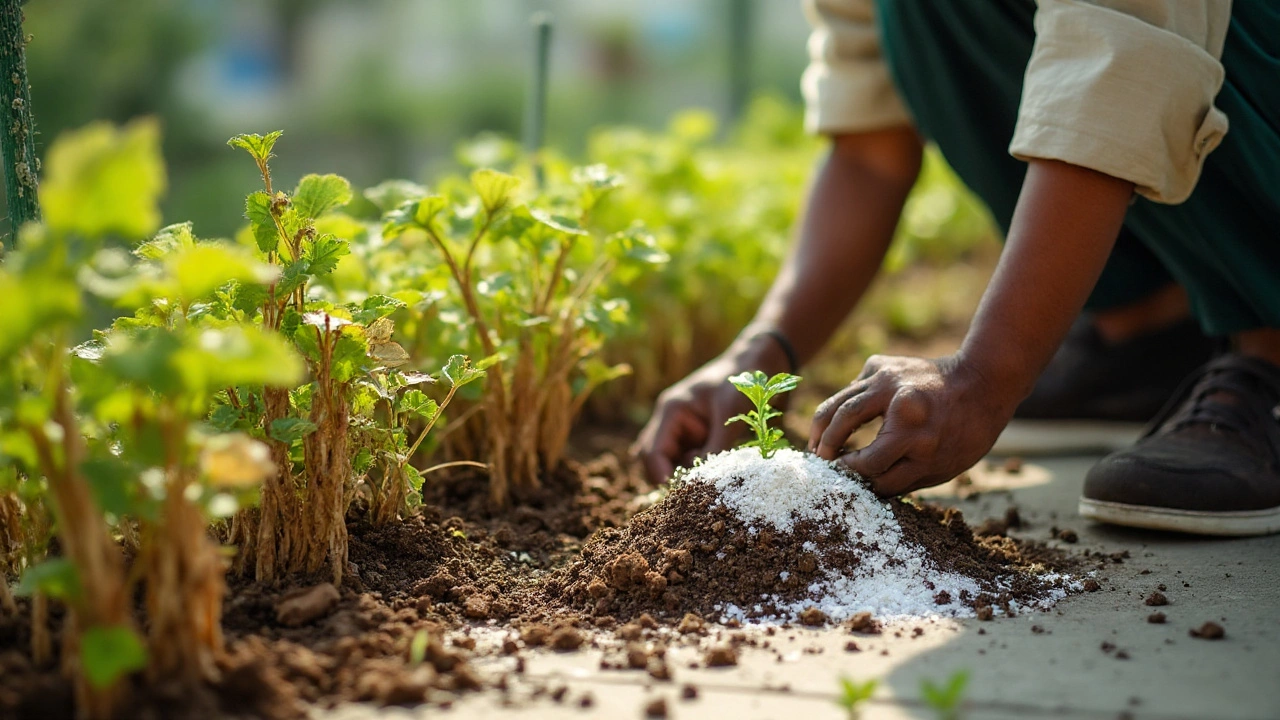Ever wonder if that white, popcorn-like stuff in your potting mix is as perfect as everyone says? Plenty of gardeners rave about perlite—swearing it transforms their soil and keeps roots happy. But here’s the kicker: perlite actually brings a few hidden headaches to the table. Let’s pull back the curtain and see why this lightweight mineral isn’t always the stress-free solution it’s made out to be.
What Perlite Really Is and How It Gets Used in Gardening
Perlite looks like tiny, foamy pebbles, and it’s everywhere in gardening—especially in those classic plastic bags of potting mix. It starts life as volcanic glass. The magic happens at around 850–900°C: that's when the stuff 'pops' like popcorn. Suddenly, one cubic meter of raw perlite balloons to about fifteen cubic meters. That air-filled structure makes it brilliant for letting in oxygen and draining water away from plant roots. Here’s the thing: this production isn’t exactly energy-efficient; creating perlite on an industrial scale chugs through a pile of fossil fuels. Compared to organic amendments like compost, perlite leaves a much bigger carbon footprint.
Gardeners add perlite for loosened-up soil, preventing compaction, and to help water drain where things get too soggy. You’ll find it sprinkled through houseplant mixes, hydroponic trays, seed starting blends, and even on golf courses to keep grass roots breathing. But what works wonders for drainage can sometimes backfire if you’re not careful.
Let’s get real: perlite isn’t a fertilizer. It’s totally sterile, so it brings no nutrients to your soil. If you skip fertilising, your plants could wind up a bit starved. And while it’s lightweight, that can be a pain, too. A gust of wind in your greenhouse or open bag? Suddenly your workspace is snowed under with floating white flakes that are easy to inhale and tough to clean up. Because perlite doesn't break down, those chips can stick around in your plant pots for years—sometimes outlasting every other soil ingredient.
Here’s a quick rundown of perlite basics, if you like seeing things side by side:
| Perlite Property | Details |
|---|---|
| Source | Volcanic glass, mined mainly in Greece, Turkey, and the USA |
| Expansion Process | Heated rapidly to 850–900°C; expands 15x original volume |
| Primary Use | Soil aeration, drainage improvement, hydroponics |
| Nutrient Content | Zero—only provides structure, not nutrition |
| pH Range | Neutral, around 7.0 |
| Lifespan in Soil | Indefinite; doesn’t decompose |
| Cost (UK, 2025) | £18–£24 per 100L bag |
So, while perlite works wonders for some jobs, it’s not the answer to every soil need. And if you’re running an organic garden or eyeing up ways to go greener, that carbon cost can feel hefty. Don't forget to factor in the risk of dust—a real issue for anyone with asthma or sensitive lungs.

Environmental and Health Concerns with Perlite
The pursuit of perfect plant roots comes with some baggage, especially with a product that’s mined, trucked, and cooked at roaring temperatures. Mining perlite means digging up landscapes, mostly in volcanic regions like Greece and Turkey—the two largest producers as of 2024—and shipping it across continents. That’s not just energy-intensive; it can strip natural habitats if done carelessly. In the UK, we don’t mine it ourselves, so every bag comes via ship, adding transportation emissions.
Processing is no small thing, either. The expansion process needs huge energy inputs. According to a recent UK government report, expanding one tonne of perlite eats up about 1,200 kWh of energy—enough to power the average British home for nearly 5 weeks! Pair this with shipping emissions, and you’re looking at a higher carbon output than something as simple as leaf mould, coir, or bark chips.
Then there’s the dust. Open a bag of perlite a bit too quickly, and it puffs out clouds of fine, lightweight dust. There's no escaping it—get it in your nose, and it’s not exactly pleasant. The NHS warns that inhaling mineral dust over time can be rough on your lungs, especially if you garden with kids, have pre-existing issues like asthma, or just like to breathe easily in your greenhouse. Perlite dust isn’t classified as a carcinogen or major irritant, but regular exposure can lead to minor respiratory trouble and dry, irritated eyes. A smart move? Wet the perlite a bit before using or wear a dust mask; neither are steps you’d bother with organic mulches.
Apart from health, there’s the question of disposal. Because perlite never rots down, it sticks around in soil long after plants are gone. That can mess with compost quality if you recycle old soil, since those small white bits never really vanish. A pile of potting mix full of perlite ends up harder to repurpose, and wildlife in your compost heap certainly won’t eat it. If you use a lot, you might spot perlite building up in garden beds year on year—possibly affecting the structure and feel of your soil over time.
If you’re working toward a wildlife-friendly or organic-certified garden, most certifiers allow perlite because it’s mineral-based and inert. But there’s a catch: it doesn’t line up with circular or zero-waste gardening ideals. It’s not refillable, cannot be composted, and—unless you scoop it out and re-use it—will eventually add to landfill volume.
When you sum up the big cost in energy, the potential local landscape impact from mining, air quality issues, and its permanent presence in soil, perlite’s green credentials look a bit patchy. It’s about weighing convenience against your environmental goals.

Does Perlite Suit All Plants—and Are There Better Alternatives?
Sounds tempting to throw perlite into every pot, right? But here’s the truth: some plants just don’t appreciate it. It’s popular with succulents, orchids, and cacti for the pure drainage, but if you’re growing moisture-loving veggies or woodland flowers, heavy perlite use can leave you watering non-stop. Seedlings can dry out faster if perlite-heavy mixes are kept in warm or sunny spots, which means more effort for you—not less.
Perlite’s pH, at around 7.0, won’t upset delicate acid-lovers like blueberries, but the sharp, abrasive texture can damage the roots of softer or younger plants. There have been cases here in Manchester where new gardeners reported root tip burn on ferns or African violets, especially when using fresh perlite straight from the bag without rinsing off dust. With hydroponic gardens, the material breaks down so slowly that tiny perlite pieces might clog up recirculating water pumps after a few years—ask anyone running a home system, and you’ll hear stories of filters blocked up with white grains after just a single season.
So what are the alternatives? It depends what you’re after. For drainage, horticultural sand or grit (often from UK quarries) doesn’t float or create dust clouds, and it gives a weightier mix for pots that sit outside. Coconut coir, which is a byproduct of the coconut industry, offers lightness, water retention, and a much lower carbon footprint—especially now that most coir comes in compact bricks, so shipping emissions are less intense. If you’re after soil aeration but want a compostable solution, try bark chips or fine pine bark; these break down over two to three years, feeding worms as they go.
For gardeners who like reusing or recycling, biochar is another strong contender. It’s made from waste wood burned in low oxygen, locks carbon into the ground, and—unlike perlite—improves soil biology long-term. Mushroom compost and leaf mould do similar jobs while feeding the soil, though they add nutrients, which perlite doesn’t. The only tradeoff: they can harbour weed seeds if not properly managed or heated.
Here’s a rough head-to-head comparison for popular perlite alternatives:
| Amendment | Water Retention | Aeration | Decomposition Rate | Carbon Footprint |
|---|---|---|---|---|
| Perlite | Low | High | Never decomposes | High |
| Coconut Coir | High | Medium | 2–3 years | Low–medium |
| Pine Bark | Medium | Medium | 2–3 years | Medium |
| Sand | Low | Medium–low | Never decomposes | Low (UK produced) |
| Biochar | Medium | Medium–high | Decades–centuries | Very low |
Don’t get me wrong—no need to banish perlite from your shed forever. It’s just that, hidden among the hype, there are real trade-offs: from air quality and health risks when handling it, to permanent soil structure changes, and a carbon cost that can dwarf what you’d spend using bark or coir. Next time you reach for that bag, weigh up your plants’ needs, your garden’s style, and maybe—just maybe—give those white flakes a break for a season.

